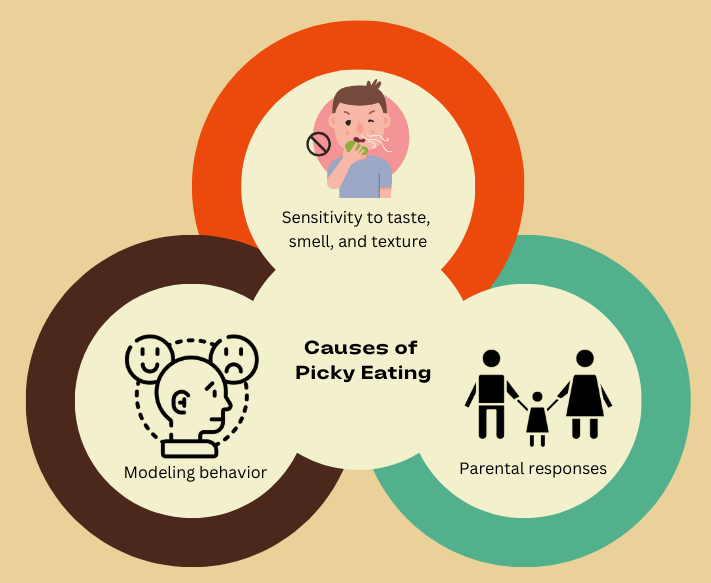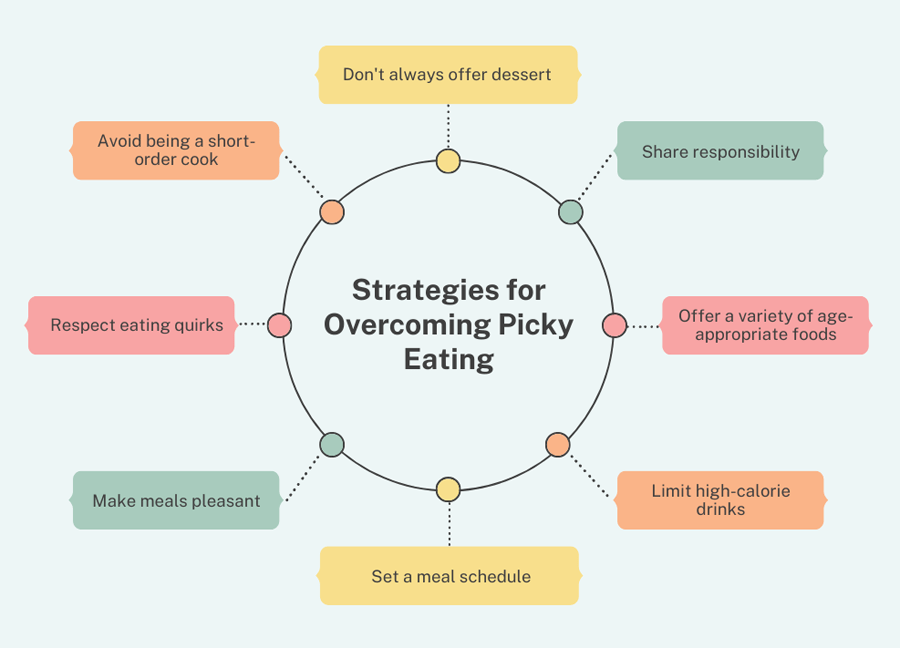Overcoming Picky Eating Habits in Children

Is your child turning mealtimes into a battleground?
Picky eating is a universal behavior in young children that may be stressful to parents and impact negatively on family relationships. While the stage can be challenging, it often resolves with minimal intervention as children grow up and experiment with new foods. Picky eating typically involves refusing or restricting both familiar and new foods, sometimes with an element of neophobia – fear of new things.
Causes of Picky Eating

There are several reasons why kids turn into picky eaters:
Sensitivity to texture, smell, and taste
Some children are more sensitive to sensory stimulation, and this makes some foods too much or unpleasant for them. For example, a child might not eat mushy vegetables such as cooked carrots because the texture tastes strange or disgusting in their mouth.
Modeling behavior
Children are likely to mimic the way they see their parents or guardians eating. If a parent is a picky eater or loudly protests about dislikes, a child can learn similar habits.
Parental responses
It can also emerge where parents utilize food as a means of control in some manner. As an example, the use of dessert as a reward for eating vegetables encourages the idea that vegetables are an aversion.
Strategies for Overcoming Picky Eating

Share responsibility
You control as a parent what, where, and when to serve food. Your child is responsible for deciding if they will eat and how much they will eat. This division of responsibility increases children’s sense of control, reducing the power struggle in meals. For example, you could serve a meal with a lot of options so your child can choose what they feel comfortable eating from what you have available.
Offer a variety of age-appropriate foods
At dinner time, serve a balanced variety with a vegetable, fruit, protein, and starch. Introduce new foods, but do not force them. Studies indicate that it can take 15 exposures before a child may try a new food. For example, continue to put broccoli on their plate even if they do not eat it at first, demonstrating to them that it is a regular part of meals.
Limit high-calorie drinks
Too much juice, soda, or milk fills kids up, so they do not have space for solid food. Juice must be limited to 4 ounces a day and milk to 24 ounces. Soda, being calorie-free but full of sugar, must be cut out. If kids are hungry at mealtime, they will be more likely to eat the good food you provide.
Create a meal schedule
Establishing regular meal and snack times helps children understand when food will arrive, reducing hunger anxiety. Offering breakfast, a mid-morning snack, lunch, an afternoon snack, and supper provides a predictable routine, allowing children to arrive at the table hungry.
Make mealtime fun
Mealtimes are key if a child will eat. Set up an informal, warm spot with enjoyable conversation, clean, well-lit dining area, and minimal distraction like television or toys. This encourages kids to focus on the food and value the social process of meal eating.
Respect eating quirks
Each child enjoys things in a different way and may react differently to the same foods on different days. If your child suddenly develops a dislike for a much-preferred food, take this in stride without making a big deal out of it. With time, children’s taste will change and they will return to foods they initially rejected.
Avoid being a short-order cook
If your child refuses to eat what you have prepared, resist the temptation to cook something else for them. This will reinforce picky eating. Offer at least one food that you know they like with the meal. This approach balances choice with inviting the acceptance of a broader range of foods.
Don’t always offer dessert
Offer dessert occasionally so that child knows that it is not a regular everyday meal. When dessert is offered, avoid making it a requirement for finishing all the food on their plate. This prevents children from overeating to get to the dessert, which creates healthier eating behaviors.
When to Seek Professional Help
While picky eating is generally a normal developmental phase, there are cases where it becomes problematic if it would lead to nutritional deficiencies or affects the child’s well-being and overall functioning. Such cases should then be tackled and the reasons behind them should be explored, perhaps because of sensory sensitivities, anxiety, or fear of food uniqueness. The pediatrician, nutritionist, or child psychologist can provide professional advice and management. These professionals can use techniques like food therapy to gradually introduce new foods in a comforting, controlled environment.
Conclusion
Pickiness is a temporary phase that most children will eventually grow out of with minimal intervention. By offering several healthy foods, maintaining a regular meal routine, creating a healthy mealtime environment, and avoiding reward or punitive-based eating practices, parents can encourage healthy, well-balanced eating in their children. But when selective eating becomes severe enough that it affects a child’s health or daily functioning, seeking help from a therapist or nutritionist can be effective in helping to break a child out of his or her food avoidance and into more variety in eating.